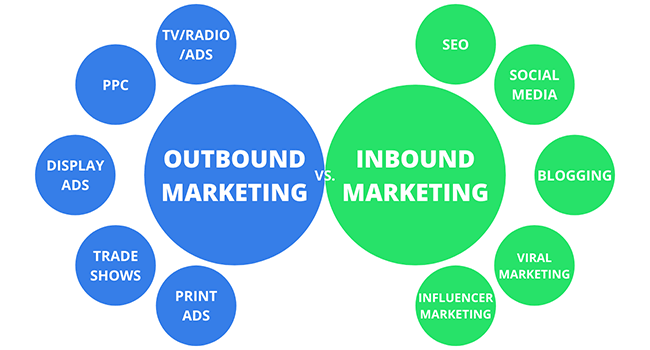Hello friends, what is inbound and outbound marketing, what is the difference between them, few people know about these topics of marketing, so guys, if you also do not know about these methods of marketing, then we will give you complete information on inbound and outbound marketing in this article, for this you must read the article completely and carefully.
So, we will try to understand both of them one by one, then in the end we will try to understand what is the difference between them, so let’s first know what is inbound marketing.

InBound Marketing
Inbound marketing is a method of marketing that attracts customers by providing them with valuable content and experiences tailored to them. Simply put, inbound marketing is the process of helping potential customers find your company. Inbound marketing is all about making connections, answering questions, and solving problems.
We can also call inbound marketing content marketing because inbound marketing is almost in line with content marketing. In inbound marketing, the customer is ready to make a purchase, we just have to attract him towards our product, attract him. Inbound marketing includes blog posts, social media, infographics, email newsletters, and other types of content that people like to read.
In inbound marketing, the company’s focus remains on potential buyers who come to them themselves, companies try to develop relationships between customers in new ways, and generate leads. For this, create quality content that attracts people to your business and brand. These methods make you attractive to customers because they do not make people feel that they are being sold something. In inbound marketing, educational, entertainment, and such content is made available to the customers. The best part of inbound marketing is that inbound marketing consists entirely of organic leads, so it depends more on the mind than the budget.
Some Examples of Inbound marketing:
- Blog posts
- Product reviews
- Social media campaigns (Facebook, Youtube, Twitter, etc)
- Ebooks
- SEO
- Video content
- Google ads
- Email Marketing
- Affiliate Marketing

Outbound Marketing
Outbound marketing is the exact opposite of inbound marketing wherein inbound marketing the customer himself comes to the company and brand whereas in outbound marketing the company and the brand go to the customers. Outbound marketing is an older form of marketing that includes TV ads, radio ads, print ads (newspaper ads, magazine ads, etc.), outbound sales calls, mobile messages, and email spam. It’s also called Push marketing.
Some examples of outbound marketing:-
- TV ads
- Radio ads
- Newspapers
- SMS
- MMS
- Spam email
- Sales Call
What is the difference between Inbound and Outbound Marketing?
| Inbound Marketing | Outbound Marketing |
|---|---|
| Inbound marketing is the promotion of your business and website through quality content such as blogs, social media, videos, podcasts, and ebooks. | In outbound marketing, your business is promoted through different types of advertisements such as TV advertisements, radio advertisements, holdings, billboards, newspapers, and magazines. |
| Inbound marketing is the new concept of marketing. | Outbound marketing is the traditional method that is out of date now. |
| Inbound marketing attracts interested customers or readers. | Trying to attract everyone whether anyone is interested in it or not. |
| Content is created by targeting the needs of the consumer. | Content is created by targeting the product. |
| Attracts customers. The customer himself comes to you for the product according to his needs. | The customer has to search. |
| Inbound marketing is more effective than outbound marketing. | Less effective than inbound marketing. |
| There is more profit because the target is the audience. | Profits are less from inbound marketing. |
Friends, hope you have understood what is inbound marketing and outbound marketing and what is the difference between them. If you have any questions related to inbound and outbound marketing, then you must comment in the comment box, we will try to answer your questions.

